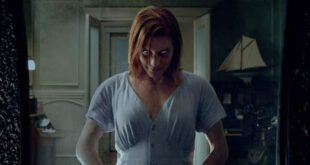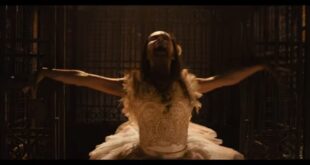Fair Warning: This review is gonna get into some heavy shit, including rape, sexual violence, and spoilers for several movies (including Last House On The Left and Silent House, among others.) Not as heavy as that Human Centipede article, but still pretty gnarly. Just lettin’ you know.
Oftentimes in the horror genre, rape or sexual violence is used as a means to incite an incident or to be used as character development, and whenever it is done, it either falls into one of two distinct camps. Either a) the incident is used in a brutal-yet-important-to-the-character’s-arc sort of way, in which the violence is used to make a statement about the story’s theme, to bring out a trait or feeling that the character must now confront, or to reveal to the character the world that they live in, and how they must now deal with that harsh reality; or, b) it is used in a cheap, throwaway style, wherein the violence is meant only to elicit a reaction from the audience, and not a single thing more. Obviously, being one who cares about characters in my media, I am biased towards the former option when this sort of thing happens.
This is always a dangerous and fragile line to traverse, of course, and there are reasons for going one way or the other; but regardless of which way the film turns, there are good and bad ways of executing this particular thematic element. In the case of films such as Last House On The Left, this sort of intense, realistic sexual violence is depicted in order to bring about a catharsis in the conclusion of the film, wherein the main girl’s parents get their bloody, righteous revenge on their daughter’s killers. That doesn’t make the violence any less easy to bear, or to watch, but there is a feeling that these villains get what is coming to them, and in no easy way. Revenge is a dish best served cold.

Other times, sexual violence is depicted in a way that feels like a cheap, throwaway plot device. In the film Silent House, for example, it is revealed that the main female protagonist was, in fact, raped and tortured for years by her father and (possibly) her uncle, which caused her to essentially hallucinate the majority of strange happenings inside the house throughout the movie. Her trauma is used as a plot twist, not as a character development, and by doing so not only strips us of any sort of catharsis in her revenge, but also denies us any of the events we’ve seen in the movie itself: after all, the haunting never really happened, did it?
Now, cut to Felt, an indie movie directed by Jason Banker and co-written by/starring Amy Everson, whose main character (also named Amy) has already experienced her trauma prior to the beginning of the film; in fact, the audience is never told outright what happened that affected her so strongly. What we do see is the way that she attempts to cope with the aftermath of the event: by creating multiple, masculine alter-egos for herself that allow her to, in a way, become that which she feels is oppressing her.

And what is oppressing her? Men. Namely, the awful, despicable men that populate the world around her, the men whom she attempts blind dates with only to listen to their awful jokes about roofies and how they don’t exist; the men that her friends date, and who treat them like garbage; and the men that she, on a daily basis, has to brush past and deal with.
Her alter-egos – taking their forms in the appearance of skin-tight, fabric costumes that she makes for herself – are her coping mechanism, a way to deal with the suffocating misogyny that surrounds her every day. It is only when she meets a guy who doesn’t openly treat her like trash does she begin to let down her defenses, but by then it may be too late, for her different personalities have already begun to populate her consciousness, and they don’t tend to take prisoners.
Now naturally, this film has its pros and cons. For one thing, the whole film is shot beautifully and eerily, letting you settle on certain images long enough only to cut away and make you feel like something sinister is waiting just around the corner. Additionally, the acting by Amy Everson is fantastic – her range of emotions, from moody to cynical to even trusting and warm in some moments, makes for an extremely compelling watch, and I was down to see this film through to the end just to see how her head worked out her, shall we say, social problems.
However, that’s a big issue I took with the film; at times, it feels overly preachy. Don’t get me wrong, I completely understand and empathize for her character – anyone that says that real men don’t act like this haven’t talked to enough of them to see the flaws in that logic – but with the combination of all the elements here, it felt like there was little care for subtlety versus bashing us over the head with it all.
Additionally, outside of Everson’s performance, I really wasn’t drawn to anyone else in the film. Her friends serve as solid stand-in supporting characters, and the men are all dripping with detestable levels of douche, but I couldn’t find myself interested in their exploits. As the movie tends to skip around in bits to show us slices from these characters’ lives in contrast with Amy’s, some relatability would have made these moments feel less aimless.

Regardless, Felt is a unique movie. Some people have been calling this a “feminist superhero movie;” some have been calling it a “tumblr thread coming to life;” still others have called it “feminist propaganda.” I would say that any and all of these descriptors would be missing the point: this movie is a slow-burner of a horror film, through and through. It is meant to make you feel uncomfortable and uneasy, and as our heroine descends into madness from despair, her journey is one that I found myself compelled to, even with its occasional choir-like methodology.
Final Thoughts:
If you’re into psychological horror with a feminist twist, then Felt will be a hell of a ride. It tends to tell a little more than show, but the tale that it tells is unique and timely, especially in a modern world full of blind dating. It’s weird, visceral, and its images will stick with you for days – all the components of a fine psychological horror film.
 PopHorror Let's Get Scared
PopHorror Let's Get Scared




